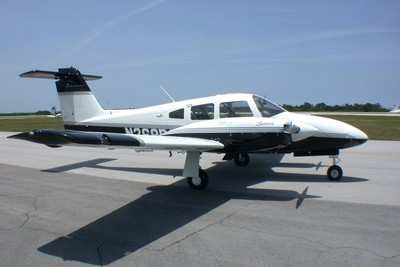Family Of Fatally Injured Man Files Against Flight School, Estate Of The Pilot-In-Command
The family of a student pilot fatally injured in an accident in Brunswick, GA in March 2014 has filed a lawsuit against the flight school and the estate of the pilot in command of the airplane at the time it went down.

The suit was filed in Jacksonville, FL, according to television stations WJXX and WTLV. The family of student pilot Adam Christopher Griffis says that Andres Santiago Lopes, who was listed as pilot in command of the flight, should not have been acting as PIC as he was a student pilot himself. The company, Airline Transport Professionals, is also named for not properly maintaining the airplane.
According to the NTSB's probable cause report from the accident, which is not admissible in court, the pilots of the twin-engine PA-44 airplane were conducting a cross-country instrument flight rules (IFR) flight. Although both pilots were instrument-rated and IFR-current, the right seat pilot had only 8.8 hours of actual instrument experience, and the left seat pilot had only 1.8 hours of actual instrument experience. While en route and likely operating in IFR conditions, radio and radar contact were lost after the airplane entered a descending, 180-degree right turn.
Examination of the wreckage at the accident site revealed signatures consistent with an in-flight breakup of the airframe. The horizontal situation indicator (the only vacuum-system-driven flight instrument that was recovered) exhibited signatures showing that it was likely not operational when the airplane impacted the ground. Both of the engine-driven vacuum pumps exhibited fractured rotors.
Although physical examination of the vacuum pumps could not determine whether the rotors fractured before or during impact, the inoperative horizontal situation indicator suggests that both pumps had failed before the impact.
The operator reported that the vacuum pump mounted to the airplane’s right engine was not operational before the airplane was dispatched on the accident flight and that the pilots had been advised of this deficiency. The operator used the Part 91 minimum equipment limitations for flights, which permitted dispatching the airplane with only one of the two engine-driven vacuum pumps operational. However, the FAA’s master minimum equipment list for the airplane for Part 91 operators, advises operators to limit the airplane to daytime visual flight rules flights when only one of the two vacuum pumps is operational. The operator’s decision to dispatch the airplane with a known mechanical deficiency and no operational limitations reduced the safety margin for the flight and directly contributed to the accident.
It is likely that the left vacuum pump failed en route rendering the vacuum-driven flight instruments inoperative. Given the pilots’ minimal flight experience operating in IFR conditions combined with the difficulty of detecting and responding to the loss of attitude information provided by the vacuum-driven flight instruments, it is likely that the pilots became spatially disoriented and lost control of the airplane, resulting in the subsequent inflight breakup. No definitive determination could be made as to which of the two pilots was acting as pilot-in-command of the airplane at the time of the loss of control.
The NTSB determined that the probable cause of the accident was an inflight failure of the airplane's only operating vacuum pump, which resulted in the loss of attitude information provided by vacuum-driven flight instruments.
Also causal was the pilots' failure to maintain control of the airplane while operating in instrument flight rules (IFR) conditions, likely due to spatial disorientation, following the failure of the vacuum pump.
Contributing to the accident was the operator's decision to dispatch the airplane with a known inoperative vacuum pump into IFR conditions.
The court documents said that Griffin's family is seeking $15,000 in compensation.
(Image from file. Not accident airplane)
 Aero-News: Quote of the Day (05.09.24)
Aero-News: Quote of the Day (05.09.24) ANN's Daily Aero-Term (05.09.24): Hold Procedure
ANN's Daily Aero-Term (05.09.24): Hold Procedure ANN's Daily Aero-Linx (05.09.24)
ANN's Daily Aero-Linx (05.09.24) Airborne 05.03.24: Advanced Powerplant Solutions, PRA Runway Woes, Drone Racing
Airborne 05.03.24: Advanced Powerplant Solutions, PRA Runway Woes, Drone Racing Airborne-NextGen 05.07.24: AI-Piloted F-16, AgEagle, 1st 2 WorldView Sats
Airborne-NextGen 05.07.24: AI-Piloted F-16, AgEagle, 1st 2 WorldView Sats



